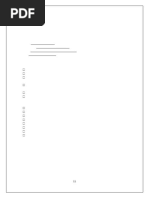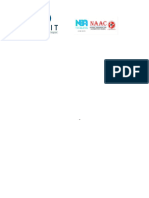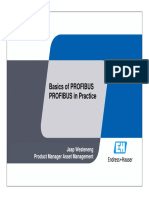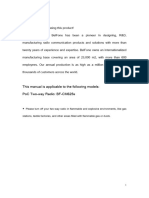Assignment 4
Uploaded by
Rahul PathakAssignment 4
Uploaded by
Rahul PathakDay 3 (function preprocessor)
1. Write a program to compute factorial and GCD using recursion. 2. Write a menu driven application that performs the functions of a calculator. The inputs from the user should be validated and error messages in case, inputs are not valid, should be displayed of multiplication, division, factorials (use recursion) and squares. Modularize the code wherever possible. 3. Write a program to reverse a string using pointers 4. Write a program that will open a file and report on the number of lines, characters, and words in a file. Have the name of the file to be opened appear as a command line argument. // optional // Write a program, which will delete only odd numbers from a linked list of integers. 5. Write a program to remove trailing blanks and tabs from each line of input, and to delete entirely blank lines.
Day 5 (files IO)
1. Take one of your previous programs and run it using the interactive debugger to examine several intermediate values.Write a program to display all the vowels in a given line of text. 2. Write a program to reverse a string using recursive functions 3. Use scanf function to read a string of characters (into character type array called text) including alphabets, digits, blanks, tabs etc except new line character. Write a loop that will examine each character in a character-type array and determine how many of the characters are letters, how many are digits, how many are blanks and how many are tabs. Assume that text contains 80 characters 4. Write a program that will concatenate two files, that is append the contents of one file at the end of another file and write the results into a third file. You must be able to execute command at DOS prompt as follows: C > CONCAT Source 1.txt source 2.txt Target.txt 5. Write a C program to open a file and store text (character type data) in ones complement form. Read the contents from the file and display as it is as well in ones complement form. Use command line arguments to pass file name to your C program
6. Write a C program to calculate factorial of a number. Factorial function has to be written as a multiline macro 1.Develop a program that reads a file containing a list of numbers, and then writes two files, one with all numbers divisible by three and another containing all the other numbers 2.Take one of your previous programs and run it using the interactive debugger to examine several intermediate values 3.Develop a program that counts the number of bits in a character array. Optimize it through the use of register integer variables. Time it o several different arrays of different sizes. How much time does you save? 4.Try examples by embedding assembly code in C and observe the performance 7. Write a program that will open a file and report on the number of lines, characters, and words in a file. Have the name of the file to be opened appear as a command line argument. 8. Write a program to remove trailing blanks and tabs from each line of input, and to delete entirely blank lines. 9. Write a program to remove all the comments from a C program. 10. Develop a program that reads a file containing a list of numbers, and then writes two files, one with all numbers divisible by three and another containing all the other numbers 11. Write a program which reads a line of characters. Each character entered from the keyboard is tested to determine its case, and is then written to the data file in opposite case. Display the contents of the file. Also use ftell and fseek to determine 15 the current file position and to change the file position 12. Write an interactive, file-oriented C program that will maintain a list of names, addresses and telephone numbers in alphabetical order (by last names). Process the information associated with each name as a separate record, represent each record as a structure. Include a menu that will allow the user to select any of the following features: a. Add a new record b. Delete a record c. Modify an existing record d. Retrieve and display an entire record for a given name e. Generate a complete list of all names, addresses and telephone numbers f. End the computation Be sure to rearrange the records whenever a new record is added or a record is deleted, so that the records are always maintained in alphabetical order. Utilize a linear linked list. Also use ftell and fseek wherever required
13. Write a program that will generate a data file containing a list of countries and their corresponding capitals. Write interactive code which will access the above created data file to perform the following operations a. Determine the capital of a specified country b. Determine the country whose capital is specified c. Terminate the programme 14. Write a program to embed assembly language code in C program Data Structures: f the masking operation is selected, prompt the user for the type of operation (bitwise and, bitwise exclusive or, or bitwise or) and then a (hexadecimal) value for the mask. If the bit shifting operation is selected, prompt the user for the type of shift (left to right), and then the number of bits
15. Write a C program that will illustrate the equivalence between a. Shifting a binary number to the left n bits and multiplying the binary number by 2n b. Shifting a binary number to the right n bits and dividing the binary number by 2n. Choose the initial binary number carefully, so that bits will not be lost as a result of the shifting operation
You might also like
- Introductory Techniques For 3D Computer Vision100% (1)Introductory Techniques For 3D Computer Vision180 pages
- ECG Viewer Manager - Prince 180D Manual V1.90% (1)ECG Viewer Manager - Prince 180D Manual V1.938 pages
- Pps Lab External Programs for Students - CopyNo ratings yetPps Lab External Programs for Students - Copy3 pages
- C Programming LAB Syllabus Programs 1 42 (1)No ratings yetC Programming LAB Syllabus Programs 1 42 (1)65 pages
- DSC Lab Manual - 17CSL38 (2018 Syllabus) - Naveen NNo ratings yetDSC Lab Manual - 17CSL38 (2018 Syllabus) - Naveen N76 pages
- Index For C++ Programming: Computer Science (083) Practical File For Class XIINo ratings yetIndex For C++ Programming: Computer Science (083) Practical File For Class XII6 pages
- Computer Science (083) Practical File For Class XIINo ratings yetComputer Science (083) Practical File For Class XII3 pages
- Model_paper_1_dean_Format_Final.docx - Google DocsNo ratings yetModel_paper_1_dean_Format_Final.docx - Google Docs4 pages
- Aneka Soal Ujian Sistem Operasi: Introduction & Overview 1No ratings yetAneka Soal Ujian Sistem Operasi: Introduction & Overview 15 pages
- SuperMap Scene SDKs - Unreal Engine (Basic) User Instruction100% (1)SuperMap Scene SDKs - Unreal Engine (Basic) User Instruction23 pages
- Dna-Ppcx-1G: Powerdna® Gigabit Ethernet I/O CubesNo ratings yetDna-Ppcx-1G: Powerdna® Gigabit Ethernet I/O Cubes3 pages
- Chapter 4 Documentation of The Current SystemsNo ratings yetChapter 4 Documentation of The Current Systems3 pages
- Basics of Profibus Profibus in Practice v111100% (1)Basics of Profibus Profibus in Practice v11144 pages
- New-ece 6003_low Power Vlsi Design_mod-dr Ashutosh Anand[1]No ratings yetNew-ece 6003_low Power Vlsi Design_mod-dr Ashutosh Anand[1]2 pages
- Verilog: Yogesh Tiwari Assistant Professor Cspit, CharusatNo ratings yetVerilog: Yogesh Tiwari Assistant Professor Cspit, Charusat40 pages
- Computer 2 0 Batch RBE E Book Hindi With Latest SSC TCS QuestionsNo ratings yetComputer 2 0 Batch RBE E Book Hindi With Latest SSC TCS Questions179 pages
- Office of Bids and Awards Committee (BAC) : Computer Laboratory (It)No ratings yetOffice of Bids and Awards Committee (BAC) : Computer Laboratory (It)4 pages

























































































